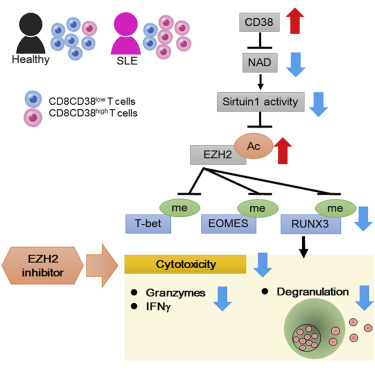Our official English website, www.x-mol.net, welcomes your
feedback! (Note: you will need to create a separate account there.)
The CD38/NAD/SIRTUIN1/EZH2 Axis Mitigates Cytotoxic CD8 T Cell Function and Identifies Patients with SLE Prone to Infections.
Cell Reports ( IF 7.5 ) Pub Date : 2020-01-07 , DOI: 10.1016/j.celrep.2019.12.014 Eri Katsuyama 1 , Abel Suarez-Fueyo 1 , Sean J Bradley 1 , Masayuki Mizui 1 , Ana V Marin 1 , Lama Mulki 1 , Suzanne Krishfield 1 , Fabio Malavasi 2 , Joon Yoon 3 , Shannan J Ho Sui 3 , Vasileios C Kyttaris 1 , George C Tsokos 1
Cell Reports ( IF 7.5 ) Pub Date : 2020-01-07 , DOI: 10.1016/j.celrep.2019.12.014 Eri Katsuyama 1 , Abel Suarez-Fueyo 1 , Sean J Bradley 1 , Masayuki Mizui 1 , Ana V Marin 1 , Lama Mulki 1 , Suzanne Krishfield 1 , Fabio Malavasi 2 , Joon Yoon 3 , Shannan J Ho Sui 3 , Vasileios C Kyttaris 1 , George C Tsokos 1
Affiliation

|
Patients with systemic lupus erythematosus (SLE) suffer frequent infections that account for significant morbidity and mortality. T cell cytotoxic responses are decreased in patients with SLE, yet the responsible molecular events are largely unknown. We find an expanded CD8CD38high T cell subset in a subgroup of patients with increased rates of infections. CD8CD38high T cells from healthy subjects and patients with SLE display decreased cytotoxic capacity, degranulation, and expression of granzymes A and B and perforin. The key cytotoxicity-related transcription factors T-bet, RUNX3, and EOMES are decreased in CD8CD38high T cells. CD38 leads to increased acetylated EZH2 through inhibition of the deacetylase Sirtuin1. Acetylated EZH2 represses RUNX3 expression, whereas inhibition of EZH2 restores CD8 T cell cytotoxic responses. We propose that high levels of CD38 lead to decreased CD8 T cell-mediated cytotoxicity and increased propensity to infections in patients with SLE, a process that can be reversed pharmacologically.
中文翻译:

CD38 / NAD / SIRTUIN1 / EZH2轴可减轻细胞毒性CD8 T细胞的功能,并确定易感染SLE的患者。
系统性红斑狼疮(SLE)的患者经常感染,导致明显的发病率和死亡率。SLE患者的T细胞细胞毒性反应降低,但是主要的分子事件尚不清楚。我们在感染率增加的患者亚组中发现了扩展的CD8CD38high T细胞亚群。健康受试者和SLE患者的CD8CD38high T细胞显示出降低的细胞毒性能力,脱颗粒以及颗粒酶A,B和穿孔素的表达。CD8CD38high T细胞中与细胞毒性有关的关键转录因子T-bet,RUNX3和EOMES降低。CD38通过抑制脱乙酰基酶Sirtuin1导致乙酰化EZH2增加。乙酰化的EZH2抑制RUNX3表达,而对EZH2的抑制则恢复CD8 T细胞的细胞毒性反应。
更新日期:2020-01-07
中文翻译:

CD38 / NAD / SIRTUIN1 / EZH2轴可减轻细胞毒性CD8 T细胞的功能,并确定易感染SLE的患者。
系统性红斑狼疮(SLE)的患者经常感染,导致明显的发病率和死亡率。SLE患者的T细胞细胞毒性反应降低,但是主要的分子事件尚不清楚。我们在感染率增加的患者亚组中发现了扩展的CD8CD38high T细胞亚群。健康受试者和SLE患者的CD8CD38high T细胞显示出降低的细胞毒性能力,脱颗粒以及颗粒酶A,B和穿孔素的表达。CD8CD38high T细胞中与细胞毒性有关的关键转录因子T-bet,RUNX3和EOMES降低。CD38通过抑制脱乙酰基酶Sirtuin1导致乙酰化EZH2增加。乙酰化的EZH2抑制RUNX3表达,而对EZH2的抑制则恢复CD8 T细胞的细胞毒性反应。











































 京公网安备 11010802027423号
京公网安备 11010802027423号